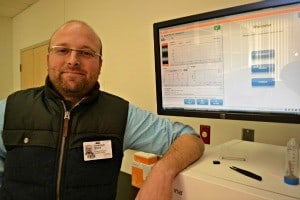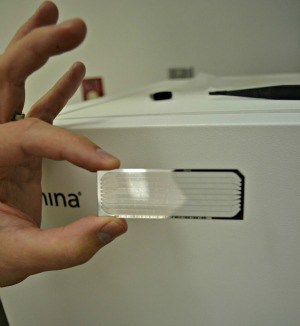New High-Tech Tool Aids Hunt for Myeloma Cure
| Dec. 12, 2012 | Understanding genetic processes in plasma cells may present a promising opportunity to develop new targeted treatments for multiple myeloma, and UAMS Myeloma Institute for Research and Therapy researchers have a new tool that will enable, for the first time, detailed examination of these processes. Thanks to an anonymous donation of $1 million, the Myeloma Institute recently acquired Next Generation Sequencing (NGS) equipment. This technology is dependent on a powerful computer system that serves to capture, catalog and analyze the enormous data streams generated from these experiments. Initial applications for the technology involve RNA Sequencing (RNA-seq), which is a new method to study ribonucleic acid (RNA). Future applications will focus on DNA-based studies. DNA is the body’s genetic blueprint from which RNA, and ultimately proteins, are derived. RNA sequencing provides a method to better study the molecular basis of cancer for individual patients as well as in a group. Insights gained will provide the basis for better diagnostics and cancer drugs, enabling earlier detection of cancer and improved patient outcomes. The Myeloma Institute has long been at the forefront of identifying the genetic fingerprint of multiple myeloma. Christoph Heuck, M.D., an assistant professor in the UAMS College of Medicine, said the new equipment offers a leap forward in the quest to identify and chart the genetic processes involved in the development of multiple myeloma. “It will allow us to better characterize multiple myeloma and see the myeloma subtypes in better detail,” Heuck said. “We may be able to identify new genetic markers that correspond with the disease or chart the response to certain drugs as well as find new targets for treatment.” Describing the mechanics behind the sequencer, Heuck said it was not unlike counting colored beads on a string, except that, in this case, scientists are counting nucleotides, the building blocks of DNA and RNA, which ultimately regulate all biological processes, including development of disease. Malignant plasma cells will be isolated from a sample of bone marrow. RNA is extracted and processed into smaller pieces, which are inserted into channels in a glass chip resembling a microscope slide. The sequencer creates a strand that matches the sample by flooding the channels with nucleotides — the molecules that make up RNA and DNA. There are four types of nucleotides, each tagged with a special dye. They react in contact with the RNA in different ways depending on the genetic code of the RNA. A laser and high-resolution camera are used to detect these reactions. This process happens over repetitive cycles, adding one nucleotide at a time. About 200 cycles per cell sample are optimal, Heuck said. With as many as 16 cell samples on one chip, a full run of a single chip can take more than a week. Analysis of the results includes comparison of the RNA strand to what is known of the human genome code to look for genetic clues about multiple myeloma development. “The biggest benefit of the new sequencing equipment is that it provides a much greater depth of detail in the molecular analysis of patient tumor samples,” said Donald Johann, M.D., associate professor of medicine and biomedical informatics in the College of Medicine. “RNA sequencing provides a vastly improved level of detail, enabling the investigation of many critical aspects of a patient’s cancer.” Johann said the cancer biology of multiple myeloma will become better understood using RNA sequencing methods. “Ultimately, we need to recognize the molecular events or derangements on an individual basis for each patient,” he said “In this way we can begin to better customize care for patients to maximize therapeutic efficacy and minimize treatment-related toxicities.” While preliminary RNA sequencing research has started, gene expression profiling continues to be the gold standard for identifying myeloma subtypes and classifying high- and low-risk disease, he said. In addition to obtaining gene profiling for active patients, the Myeloma Institute has begun a project, also funded through philanthropy, to conduct gene profiling on tissue samples that had been collected before the technology existed. Data from this project, along with data from the new RNA sequencing project, are expected to yield more detailed clues about the biological nature of multiple myeloma, with the ultimate goal of developing more advanced, targeted and individualized therapies, Johann said. Established in 1989, the Myeloma Institute was the first center in the world devoted exclusively to research and clinical care of multiple myeloma and related disorders. |

